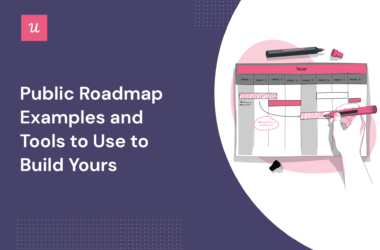Founders have all sorts of reasons for starting companies. Sometimes it’s because they’ve personally experienced a pain point and want to address it. Sometimes they’re dissatisfied with what’s available on the market and think they can do better. And sometimes it’s because they have an idea that they think could be a smashing success and they want to pursue it.
As Teresa has written before, this last scenario is the most common. But it’s also problematic. Here’s Teresa’s take:
When we start with an idea, the scope of our discovery work becomes, “Is my idea good or not?” This framing is rife with bias. The more we invest in an idea, the more likely we’ll fall in love with it (this concept is called escalation of commitment, a bias described in Robert Cialdini’s Influence).
Escalation of commitment, in turn, exacerbates confirmation bias. This means that even when startup founders are motivated to test their ideas, they are more likely to notice the evidence that suggests their idea is fantastic and miss the evidence that suggests their idea is flawed.
The longer they work on their idea, the more invested they become, increasing the likelihood they miss the negative feedback altogether. It’s a vicious cycle.
For today’s Product in Practice, we caught up with Kranthi Kiran, the Founder of ThoughtFlow.
Kranthi recently shared a story in the Continuous Discovery Habits community about how continuous discovery, specifically customer interviews, has helped him break away from some of his previous approaches to building a company and focus more on what customers and prospective customers care about most.
Do you have a Product in Practice success story you’d like to share? You can submit yours here.
Meet the Continuous Discovery Champion, Kranthi Kiran
Kranthi is the founder and technical lead at ThoughtFlow, a collaboration platform for ideation, prioritization, and strategic thinking. ThoughtFlow combines the visual flow of a whiteboard with the data modeling of a spreadsheet so that teams can shape their journey from an idea to its outcome without creating silos and losing context across multiple tools.
Kranthi finds himself in an interesting role as a third-time technical founder. He says, “My earlier approach to building products was to start with an idea, build a product, and then market it.” But this tactic was ultimately unsuccessful, which led Kranthi to realize the importance of discovery. He began reading books like The Lean Startup by Eric Ries and The Four Steps to the Epiphany by Steve Blank.
When Kranthi got the idea for ThoughtFlow, instead of starting to build it, he posted on LinkedIn and spent around six months talking to people who showed interest, trying to understand their workflows and challenges.
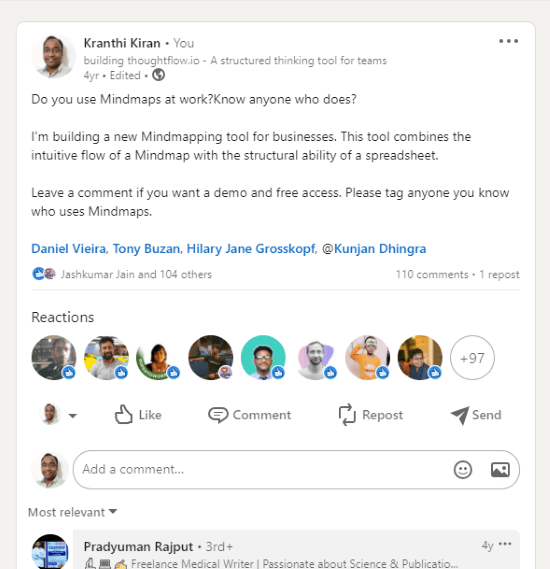
Kranthi’s original LinkedIn post where he began to collect people’s ideas about mind mapping in a business context.
A lot of these potential users were product managers, which got Kranthi interested in the field of product management and potential use cases for a tool like this.
One of the use cases Kranthi discovered was the opportunity solution tree (you can see how to build an opportunity solution tree in ThoughtFlow in this video). “Learning more about opportunity solution trees, I got introduced to Teresa’s book and community and this was a transformational phase in the way we now approach our product decisions,” says Kranthi.
Learning more about opportunity solution trees, I got introduced to Teresa’s book and community and this was a transformational phase in the way we now approach our product decisions. – Tweet This
The Challenge: Converting Trial Users to a Paid Version
One use case for ThoughtFlow, a mind mapping integration, emerged based on a user’s pain point. Kranthi says they first discovered this use case when a user complained that they made a lot of mind maps on their local machine in mind mapping tool Xmind, but their team worked on a project management tool like Trello or monday.com. This meant the team had visibility into what they needed to work on, but didn’t have the clarity and context of why they were doing something.
Based on these insights, ThoughtFlow built a mind mapping add-on for monday.com where users could make a mind map inside monday.com and sync nodes on a mind map into tasks and assign them to their team.
In the first year, they got a lot of users trialing the product, but not many were upgrading to a paid plan or team plan. Their outcome was to increase the conversion rates from free to professional plans and from there on to a team plan.
At this stage, the ThoughtFlow team faced several challenges. They were working on multiple features simultaneously, which all addressed different product and customer outcomes. This led to burnout because they were working on too many different things and the backlog was constantly growing. At the same time, it wasn’t clear how to prioritize or decide what to do. Kranthi says, “Team members would come back to me frequently and ask what they should work on next. And I’d make decisions on the fly and assign them work items (sometimes just to keep them engaged).”
After joining the CDH community and sharing his challenge, Kranthi says Teresa encouraged him to conduct user interviews more frequently with a focus on specific outcomes. “This helped us identify and focus on use cases that were aligned with our goal of profitability,” he says.
Conducting frequent user interviews with a focus on specific outcomes helped us identify and focus on use cases that were aligned with our goal of profitability. – Tweet This
Deciding to Make Customer Interviews a Regular Habit
Up until this point, the ThoughtFlow team would simply funnel user requests into their backlog. “Our approach to prioritization was basically to build the most requested feature,” says Kranthi.
For example, one feature they’d spent months building was “keyboard-based navigation.” Kranthi explains, “We built this because this was a standard in other mind-mapping tools and users missed it in our tool. Looking back, a better way to address this opportunity would have been to build an ability to import mind maps from other tools into ThoughtFlow. This would completely remove the need for editing and decrease the time to get their job done.”

Instead of adding a keyboard navigation feature to ThoughtFlow, Kranthi says it would have been better to focus on allowing users to import their mind maps from other tools. Click the image to see a larger version.
After hearing Teresa’s suggestion to regularly speak to users, the ThoughtFlow team committed to regular customer interviews. “Whenever a user would reach out for support, we would nudge them to participate in a research interview where we asked about their team, their projects, and their workflows,” explains Kranthi. These nudges were often as simple as emailing a response, asking them if they’d be willing to participate in a conversation, and including a link to schedule time for a call.
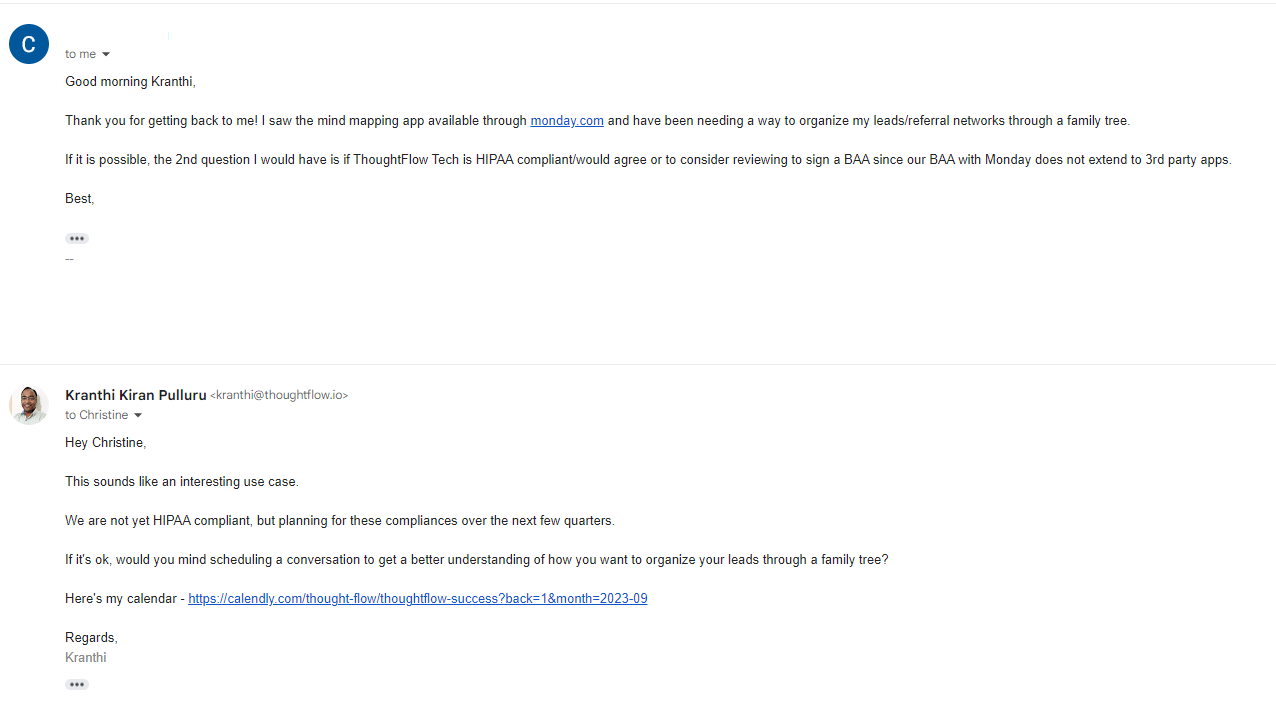
Kranthi tried to find users to speak with as often as possible and tried many tactics like responding to feature requests by asking to schedule an interview. Click the image to see a larger version.
These regular interviews were illuminating for the ThoughtFlow team. “Today, we try to understand a user’s motivation behind every request and map it to pain points and opportunities on our opportunity solution tree,” says Kranthi. “We then ideate on multiple solutions and select one before starting on development.”
Today, we try to understand a user’s motivation behind every request and map it to pain points and opportunities on our opportunity solution tree. – Tweet This
For example, if users share stories about feeling stuck or not knowing how to use the tool, this connects to the opportunity, “I don’t know what to do next,” which is connected with several potential solutions like an in-app guide, welcome email, or onboarding tooltips.
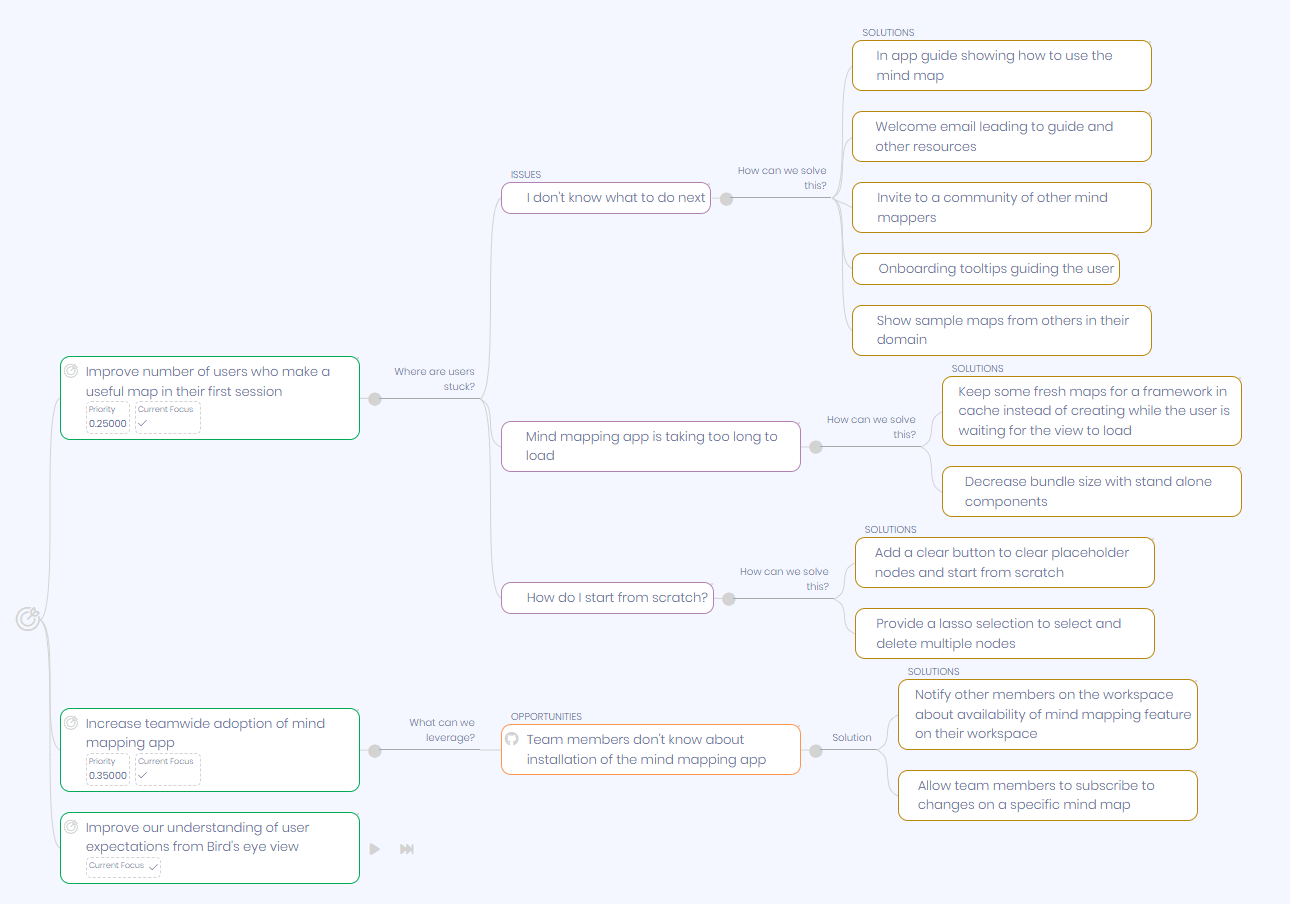
Kranthi makes sure insights from customer interviews and interactions are captured on the opportunity solution tree. Click the image to see a larger version.
They started a weekly ritual to observe screen recordings together as a team and map the observed frustrations to opportunities and outcomes in their opportunity solution tree. While they initially started with Hotjar, they eventually shifted to PostHog since it allowed for both qualitative (screen recordings) and quantitative analysis (funnels, events) in one place.
For example, the PostHog screenshot below shows interactions that indicate progress towards expected user behavior. The top two are publicly released, and the bottom ones are in beta. “These funnels help us identify the specific point of the user’s experience,” says Kranthi. “We focus our outcomes on areas in the funnel where we notice the biggest drop.”
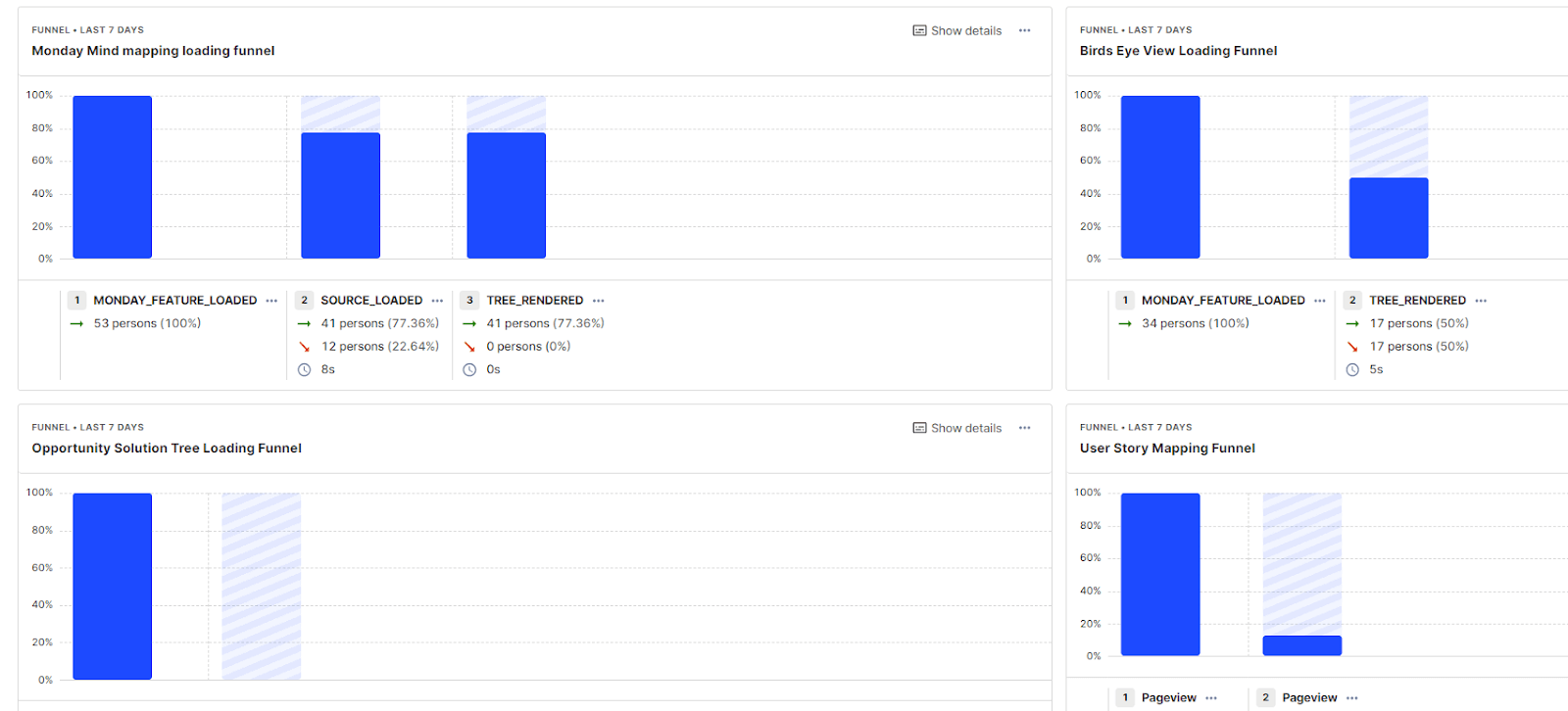
PostHog dashboards like the one shown here allow Kranthi to see a user’s interactions that indicate their progress toward an expected user behavior. Click the image to see a larger version.
Using Interviews to Identify a New Use Case
One common pattern that emerged from these interactions was that most users did not want to create a mind map, but wanted to visualize information that they already added on their boards. They wanted to use mind maps for visualizing and not for brainstorming. “These users saw creating new mind maps as a duplicated and unnecessary effort, which was the reason for churn,” says Kranthi.
Armed with this new insight, the ThoughtFlow team built a new app called Bird’s Eye View for monday.com which fetched information from different boards and automatically generated a mind map view. The initial launch of this app got a great response from managers from large companies and monday.com’s sales team.
In addition to the positive reception this app has received, Kranthi has already seen major changes within ThoughtFlow. “Continuous discovery habits have transformed our approach from conviction-based decision-making to evidence-based decision-making,” says Kranthi.
Now they clearly define success criteria for any activity that they take up. This success criterion is based on a metric associated with user behavior and not just limited to acceptance criteria. “We recently realized that there is a large drop in users who install the app, but don’t make their first map,” says Kranthi. Earlier, a task for fixing this would have been something like adding a “how to use guide” for a user to learn how to make a mind map. Now, a typical task like this will be to add visuals in the user’s first-time usage flow. “Ideally, this should cause a significant improvement (>40%) in the percentage of users who make their first map. We could experiment with animated gifs, videos, or an in-app guide.”
The team is now working on fewer ideas at a given time, but has more clarity on the expected outcome for every effort. Users and partners are more receptive to their updates, and most importantly, they’re seeing an uptick in the number of team-level upgrades.
Key Learnings and Takeaways
One of Kranthi’s biggest learnings so far is to adopt the story-based interviewing technique to identify opportunities during customer interviews. “In my earlier interviews I had a bad habit of interrupting customers with solutions or ideas before fully understanding their needs,” says Kranthi. “It took a lot of practice to control this instinct and schedule future calls for proposing solutions.”
Another big takeaway is not to expect instant results. “Like most good things in life, continuous discovery takes time,” says Kranthi. “There will be a lot of trial and error to figure out what works for you. Start with small changes to create momentum and buy-in for bigger changes. Be patient with your team and stakeholders. Appreciate any small behavior changes in your team towards becoming more discovery-oriented.”
Like most good things in life, continuous discovery takes time. There will be a lot of trial and error to figure out what works for you. – Tweet This
Want to make regular customer interviews a habit on your product team? Join the next cohort of Continuous Interviewing to develop your interviewing skills in a supportive setting.
The post Product in Practice: Making Customer Interviewing a Habit in an Early-Stage Startup appeared first on Product Talk.
Product in Practice: Making Customer Interviewing a Habit in an Early-Stage Startup was first posted on January 17, 2024 at 6:00 am.
©2022 “Product Talk“. Use of this feed is for personal non-commercial use only. If you are not reading this article in your feed reader, then the site is guilty of copyright infringement. Please let us know at support@producttalk.org.





